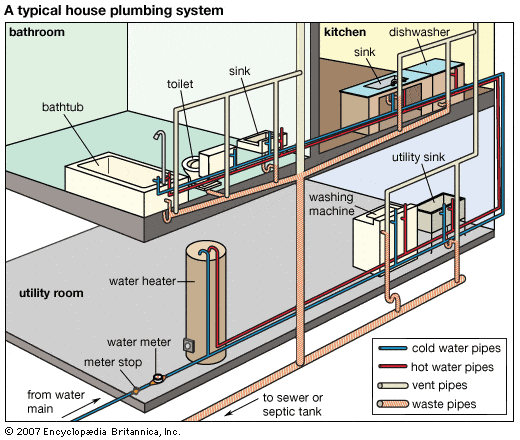At Lakeway Municipal Utility District (LMUD), customer water use is metered, but wastewater charges are averaged. This means that LMUD customers are charged for the amount of water passing through their assigned water meter during any given billing cycle. However, the water flowing out of their home or place of business is not metered, but must also be treated by LMUD, therefore charges for this service must be calculated another way. LMUD determines their customers’ charges for wastewater service based on “Winter Averaging” which takes place November through February each year. What’s Winter Averaging? First, let’s discuss the basics:
Plumbing 101

There are at least two sets of separate plumbing subsystems running through every home or place of business: pipes that supply clean, treated water into the facility and those that carry used water (known as “wastewater”) out. Both of these systems require the water to be treated. The clean water originates at LMUD’s water treatment plant where certified water operators convert raw water from Lake Travis to drinking water standards. The wastewater, if not managed by an onsite sewage facility (septic system), is directed to LMUD’s wastewater/recycled water treatment plant where the soiled water is treated to the highest standards required for safe reuse in irrigation systems. LMUD charges their customers for the water they use from the water treatment plant by installing a water meter at the edge of each property; because there is not a separate meter on the wastewater lines, an alternate method for tracking usage is needed. Many utilities utilize what is known as “Winter Averaging” to estimate this usage from year to year.
This period of outdoor low usage is when we implement “Winter Averaging” to get a better average for how much of our customers’ water use is directed to our wastewater treatment plant.
Tracking Wastewater Volume
Think of all the ways you use water in your house: bathing, flushing the toilet, washing clothes and dishes, cooking, etc. Where does all of this water go? Now, think of all the ways you use water outside the house: to irrigate landscaping, wash the car, fill the pool, etc. Where does all of this water go? Typically, your indoor water use runs into your wastewater plumbing subsystem and eventually to our wastewater treatment plant. The water you use on the outside of your house, however, either seeps into the ground or is evaporated. Think about what time of year your outdoor water use is highest. Summer, right? When temperatures are high. Outdoor use is minimal in winter because most landscaping is dormant and outdoor activities are minimal. This period of outdoor low usage is when we implement “Winter Averaging” to get a better average for how much of our customers’ water use is directed to our wastewater treatment plant.
What is “Winter Averaging”?
Now that we understand some background, we can get into the details of Winter Averaging. LMUD’s customer water meters are read two times during the period of Winter Averaging which spans November 1 through March 1 each year, so if customers minimize their water use November through February, they can greatly decrease their water bills for the following year! As an example:
To be clear, Winter Averaging does not affect the customer’s clean (potable) drinking water volume charges.
| Winter Averaging Period | Dates New Charges Appear on Water Bills |
| November 2020 – February 2021 | December 2021 – October 2022 |
| November 2021 – February 2022 | December 2022 – October 2023 |
| November 2022 – February 2023 | December 2023 – October 2024 |
We use the lower water volume from the Winter Averaging timeframe to calculate the customer’s next fiscal year wastewater volume charge.
- The maximum we bill for is 30,000 gallons.
- The minimum we bill is 2,000 gallons.
- If one cycle is “0”, we bill the total for the other cycle.
- New customers are billed our customer average which is 12,000 gallons for at least the first fiscal year.
Water Vs. Wastewater Charges
To be clear, Winter Averaging does not affect the customer’s clean (potable) drinking water volume charges. Potable water volume charges are calculated by the amount of water flowing into a home or place of business through the water meter assigned to each property. The charge will vary from billing cycle to billing cycle (every two months). However, wastewater volume charges are averaged out to remain the same on each bill cycle for 12 months, starting with the December following the Winter Averaging Cycle in which the new rate was calculated.
Still have questions? Contact our office at (512) 261-6222 ext. 110.

 You are now being redirected to the WaterSmart page.
You are now being redirected to the WaterSmart page.